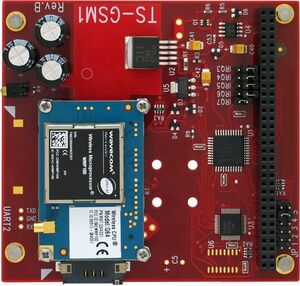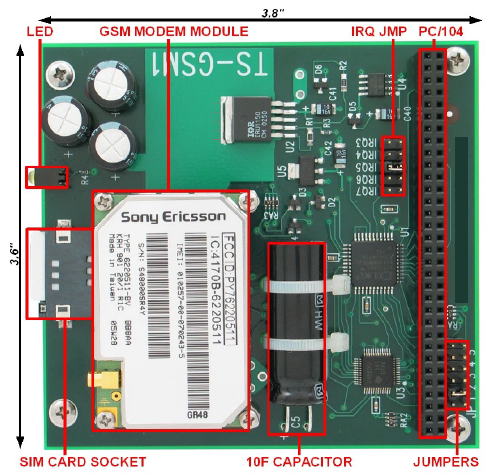TS-GSM1
 | |
| Documents | |
|---|---|
| Schematic | |
| Q64 Technical Specification | |
| Q64 Software User Guide | |
| Q64 Open AT Application Development Guide |
Overview
TS-GSM1 is a PC/104 (standard format) peripheral board that works with all Technologic Systems x86 and ARM embedded PCs to provide wireless GPRS Internet connectivity through GSM cellular service providers. Hardware features and specifications include:
- Standard 16C550 COM port interface
- Standard baud rates up to 115.2 Kbaud supported - 230 Kbaud supported in x2 mode
- Jumper configurable as COM1 through COM8
- Standard GSM SIM card socket
- Includes hardware standoffs for mounting modem module
Use one of the supported Sony-Ericsson cellular modem modules with this board for an off-the-shelf, low-cost solution.
- Sony-Ericsson GR47 dual band GSM cellular modem (Europe)
- Sony-Ericsson GR48 dual band GSM cellular modem (North America)
- Sony-Ericsson GR64 quad band RoHS GSM cellular modem (Europe and North America)
| Note: | The Sony-Ericsson GR64 cellular modem module is a RoHS quad band GSM/GPRS Class 10 compact Radio. For designs requiring RoHS (Restriction of Certain Hazardous Substances) compliance it will replace either the GR47 or GR48.
|
Hardware Configuration
TS-GSM1 shown with optional Sony-Ericsson GR48 cellular modem and Panasonic Gold 10 farad capacitor

Jumper settings for COM/IO selection
| COM | I/O | JP1 | JP2 | JP3 |
|---|---|---|---|---|
| COM1 | 3F8 | OFF | OFF | OFF |
| COM2 | 2F8 | ON | OFF | OFF |
| COM3 | 3E8 | OFF | ON | OFF |
| COM4 | 2E8 | ON | ON | OFF |
| COM5 | 3A8 | OFF | OFF | ON |
| COM6 | 2A8 | ON | OFF | ON |
| COM7 | 3A0 | OFF | ON | ON |
| COM8 | 2A0 | ON | ON | ON |
Jumper settings for PLD registers base address
| Base Address | JP4 |
|---|---|
| 0x140 - 0x14F | OFF |
| 0x190 - 0x19F | ON |
Status of modem power after system reset
| Modem status | JP5 |
|---|---|
| Turned OFF | OFF |
| Turned ON | ON |
Hardware Configuration
Jumpers are used to select one of eight standard COM port addresses for easy installation. The standard SIM (Subscriber Identity Module) card socket allows instant installation of a standard GSM SIM card from any GSM cell phone.
The on-board LED indicates modem status and can assume three states:
| LED State | Description |
|---|---|
| Solid OFF | Modem is powered OFF |
| Solid ON | Modem is powered ON, but has no connection to the network |
| Blinking at 2Hz | Modem is powered On and connected to the network |
In addition, the optional 10 Farad capacitor provides enough voltage for the modem internal registers in the absence of the main power supply. That “backup” power keeps the internal register in nonvolatile state, enabling faster network connection after modem reset or powered off.
Base PLD Register Map
The TS-GSM1 implements 5 PLD registers which appear at the selected base addresses. All PLD registers are only 4 bits wide (bits 0-3). Bits 4-7 are not driven and are undefined.
| I/O Addr | Description | Data | Bits and such |
|---|---|---|---|
| Base + 0 | Board identifier | Read only | Always returns Hex 0x9 |
| Base + 1 | PLD version | Read only | Returns a Hex 0x6 at first access Returns a Hex 0x7 at second access Returns a Hex 0x8 at third access Returns a Hex 0xV at fourth access *where V = PLD Version |
| Base + 2 | Jumpers register | Read only | Bit 3 = JP4 (1=on, 0=off) PLD base address Bit 2 = JP3 (1=on, 0=off) COM/IO decode Bit 1 = JP2 (1=on, 0=off) COM/IO decode Bit 0 = JP1 (1=on, 0=off) COM/IO decode |
| Base + 3 | Status register | Read only *Bit 0 is R/W |
Bit 3: JP5 status (1=on, 0=off) Bit 2: LED status (1=on, 0=off) Bit 1: Modem power status (1=on, 0=off) Bit 0: Modem power control (1=on, 0=off) (R/W) |
| Base + 8 | Baud Rate control register | R/W | Bit 0: If this bit is set, then the baud clock to the 16C550 UART is doubled, allowing speeds up to 230 Kbaud. This bit is set to zero at reset. |
| Note: | Bit 0 at [Base + 3] controls whether the modem is turned on or off. Even if JP5 is installed and the modem is turned on after system reset, software can still turn the modem off by clearing bit 0. It takes about 750 mS for the modem to change state after bit 0 is changed. Bit 1 at [Base + 3] (Read only) actually indicates the true state of Modem. |
Driver Support
The TS-GSM1 board utilizes standard "GSM AT Modem" commands and provides status and data via the serial COM port. The standard serial 16C550 COM port interface appears as a selectable PC-compatible COM port for software compatibility and no special drivers are required. For example, the TS-Linux distribution already includes Linux drivers for the 16C550 UART chip by default. One can use any terminal emulator, as minicom, to open and configure the serial port in use by this board with the appropriate /dev entry, enabling communication to the modem device plugged on the socket.
The GR48 or GR47 modem, when shipped from Sony-Ericsson, is set to 9600 baud by default. Therefore, the customer must configure the terminal emulator to use 9600 baud the first power up, then can use AT commands to change the baud rate. The speed settings of the modem are nonvolatile, meaning that it keeps the last configuration after power is cycled, even without the 10F capacitor installed.
Testing the GR48 Modem
The GR48 has several modes: voice, CSD (dial-up modem), GPRS (TCP/IP), GPRS (embedded TCP/IP) and FAX. The Sony-Ericsson modem uses a SIM card identical to the one found in a GSM cell phone. Insert the SIM card from a GSM cell phone into the TSGSM1 and the modem device will function on the cell network. The cellular account must have a CSD (circuit-switched-dialup) enabled account. In the US, Cingular and T-Mobile are GSM networks that offer CSD accounts.
Using the module in GPRS (embedded TCP/IP) data mode, which uses the built in TCP/IP stack, will allow you to test the module using CSD. You can run a terminal emulator and enter ATDT commands to make a dial-up modem connection. The moedem module and the TS-GSM1 UART must be programmed to run at the same baus rates. Sony-Ericsson ships the modem module at 9600 baud. The modem module can be programmed to run at higher baud rates via an AT command. . For example, the command AT+IPR19200 will set it to 19200. The command AT&W saves the modem settings. The following are some useful GR48 commands of interest:
- AT+CSQ<CR> : gets signal strength
- AT+CREG<CR> : gets registration status
- AT+IPR?<CR> : shows baud rate setting
- AT+COPS?<CR> : shows cell network name
- AT+CFUN=1<CR> : enables all functionality of the device, including RF
For further information on modem configuration and AT commands, refer to the TS-GSM1 webpage or to the GSM Modem Manual provided by the manufacturer. Also, the communication examples found on TS-MODEM Manual can be applied to this board.
Usage
BAND select
While the modem is a quad band, you must select the command with the WMBS command:
| Command | Selected band |
|---|---|
| AT+WMBS=0,1 | Mono band mode 850 MHz is selected |
| AT+WMBS=1,1 | Mono band mode extended 900 MHz is selected |
| AT+WMBS=2,1 | Mono band mode 1800 MHz is selected |
| AT+WMBS=3,1 | Mono band mode 1900 MHz is selected |
| AT+WMBS=4,1 | Dual band mode 850/1900 MHz is selected |
| AT+WMBS=5,1 | Dual band mode extended 900/1800 MHz is selected |
| AT+WMBS=6,1 | Dual band mode extended 900/1900 MHz is selected |
| Note: | The second parameter indicates when the change would take effect. Using 1 makes the change immediately and restarts the GSM stack. Using 0 will change the stack on the next reset. |
Usage with 3rd party devices
Please note that while efforts are made to follow the PC/104 specification this peripheral is not tested with third party SBCs or connected peripherals. This card is not guaranteed to operate as intended when third party PC104 peripherals or SBCs are connected.